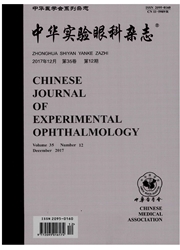

 中文摘要:
中文摘要:
背景临床实践发现角膜塑形镜具有延缓近视及眼轴长度进展的效果,但对于角膜塑形镜配戴的相关作用机制,特别是角膜塑型术对视网膜中心和周边的离焦作用机制尚不完全清楚。目的观察低中度近视儿童配戴角膜塑形镜和框架眼镜6个月后周边屈光度以及相对周边屈光度(RPR)的变化。方法采用随机对照临床试验方法,于2014年6月至2015年1月在北京同仁眼科中心招募屈光度为-0.50~-6.00 D的低中度近视儿童100例,平均年龄(11.0±1.9)岁,均纳入右眼进行研究。受试者按入组顺序编号后由SAS统计软件PROC PLAN过程语句随机均分为角膜塑形镜组和框架眼镜组,每组50例50眼,戴镜时间均为6个月。采用开放视野红外自动验光仪分别测量戴镜前后中央0°、颞侧15°和30°、鼻侧15°和30°径线的屈光度,观察并比较各组受试眼戴镜前后周边屈光度和RPR(周边屈光度与中央屈光度差值)变化趋势。结果角膜塑形镜组和框架眼镜组受试者戴镜前屈光度分别为(-3.35±1.31)D和(-3.01±1.15)D,差异无统计学意义(P=0.201)。角膜塑形镜组受试眼戴镜前鼻侧30°、鼻侧15°、中央0°、颞侧15°和颞侧30°径线周边屈光度分别为(-2.28±1.60)、(-3.28±1.41)、(-3.40±1.23)、(-3.38±1.12)和(-2.09±1.29)D,受试眼除颞侧30°外戴镜后6个月近视度数均下降,戴镜前后鼻侧30°、鼻侧15°、中央0°、颞侧15°屈光度变化值分别为(0.29±1.67)、(0.85±1.66)、(0.92±1.76)和(0.66±1.66)D,其中鼻侧15°、中央0°、颞侧15°与戴镜前相比差异均有统计学意义(均P〈0.05)。框架眼镜组受试者戴镜前鼻侧30°、鼻侧15°、颞侧15°和颞侧30°径线周边屈光度分别为(-1.88±1.30)、(-2.66±1.18)、(-2.89±1.27)和(-1.94±1.31)D,戴镜后6个月上述各径线近视度数均增加,戴镜前后
 英文摘要:
英文摘要:
BackgroundIt has been reported that orthokeratology has the effects of slowing down myopia progression and axial elongation.However, the affecting mechanism of orthokeratology wearing on ocular peripheral refraction is still not elucidated.ObjectiveThis study was to observe and compare the changes of ocular peripheral refraction and relative peripheral refraction (RPR) in low to moderate myopic eyes of children after wearing orthokeratology lens and spectacles for 6 months.MethodsA randomized controlled clinical trial was carried out after approval of Ethic Committee of Beijing Tongren Hospital and informed consent of guardians of the children.One hundred myopic children aged (11.0±1.9) years were recruited in Beijing Tongren Hospital from June 2014 to January 2015, with the diopter of -0.50 to -6.00 D. The subjects were randomized into orthokeratology group and spectacles group by the process PLAN PROC of software SAS 9.1.3, 50 for each group.The subjects in the orthokeratology group wore orthokeratology lens for 6 months and those in the spectacles group wore spectacles for the same period.An infrared open-field autorefractor was employed to measure the refraction at central 0°, temporal 15°, temporal 30°, nasal 15°and nasal 30° radial lines before and after wearing lens for the assessment and comparison of the changes of peripheral refraction and RPR.ResultsThere was no significant difference in spherical equivalent between the orthokeratology group and the spectacles group before wearing lens ([-3.35±1.31]D versus [-3.01±1.15]D, P=0.20). The peripheral refraction values in the orthokeratology group were (-2.28±1.60), (-3.28±1.41), (-3.40±1.23), (-3.38±1.12) and (-2.09±1.29)D at nasal 15°and nasal 30°, central, temporal 15° and temporal 30°radial lines before wearing lens, and reduced by (0.29±1.67), (0.85±1.66), (0.92±1.76) and (0.66±1.66)D at nasal 30°, nasal 15°, central and temporal 15° after wearing lens, respectively, with significan
 同期刊论文项目
同期刊论文项目
 同项目期刊论文
同项目期刊论文
 期刊信息
期刊信息
